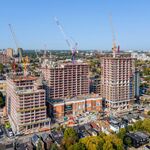I disagree. When you are basing your expense/revenue model around some specific number, then that becomes your driving mantra.
Is transit a service, or is it an exercise in creative cost accounting? The metric of a _proper_ transit service should be how many patrons are served, not how much their fares are subsidized.
Are you asking, really, or as a hypothetical ideal, where we live in a world where everyone travels in free buses on empty roads?
I might agree with you that transit is a "service" but it doesn't change the fact it's paid for through a combination of taxes and fares, staffed by employees and decisions are made by politicians. York Region isn't unique in having a fare recovery target. How transit is funded (or rather not funded) in this country is a huge issue but the idea that YR council wants to achieve a balanced subsidy is not, by itself, some sort of evil.
(And FWIW, the number of patrons served has gone up exponentially in the past decade. I don't think "patrons served" is any more a metric of success than a balanced budget, unless you manage a McDonald's. Transit should be easy to use, relatively inexpensive and get you where you need to go in a reasonable amount of time. As previously discussed, there are several factors beyond the control of council or YRT [i.e. YR's huge size, the TTC on its border] that make all of this difficult.)
Some creative thinking (ride to/from TTC for a buck or so) could help.
So now YRT is hiring an employee to check where everyone is getting off the bus? Or do we go by the honour system - put a jar by the rear doors? What you're talking about is fare integration and that has to happen at the provincial level; YRT can't do it. There's "creative thinking," and then there's impossible-to-implement solutions to complex, systemic issues with transit in the GTA.
But I'm not sure. With all due respect to the planners, when I asked about service cuts to a local route, he replied "but we're adding to the Bathurst route". I thought -- does that mean I should move along Bathurst to get better service?
The region has been moving to concentrate transit service and development on corridors, including Bathurst. That's not really any more unusual than knowing that you can get better service closer to Yonge Street in Toronto. It's clear their cuts to the local routes are making things difficult - I'm not being glib - but, yeah, live closer to the main streets in a suburban municipality and you have a better shot at reliable service.
These are growing pains- YR is bumping up against the limits of what it can do on its own. It's a suburb trying to be more transit oriented but confronting a lot of issues. Maybe I'm naive about their hearts being largely in the right place but it's not the sort of thing you can change overnight.




